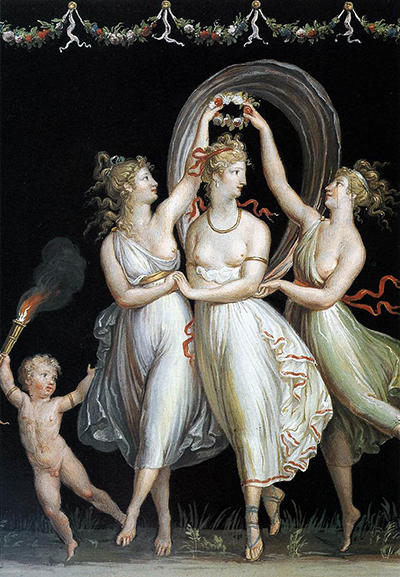At the end of the 18th century Antonio Canova would produce several different paintings based on the theme of the Three Graces, all of which were created using tempera on paper. The dancers would be joined by several cupids across the different versions to add another body of work to an already impressive oeuvre.
It is believed that this particular artwork is now owned and on display at the Canova Museum, Possagno, Italy. They mainly focus on sculpture, with also a large number of moulds from his career, but other mediums are also included to a smaller degree. We understand that these paintings of the Three Graces was purely produced out of love for the content and artistic expression more generally, rather than being requested by a patron for a specific commission. Mythological figures would dominate much of this artist's career but in the case of his work in tempera he was able to incorporate a variety of colour as well. He would produce these portraits upon a darker background which then helped these tones to really stand out even more. Sadly, his paintings have not been researched in huge amounts of detail and so we are a little limited in what we know about this part of his career.
One of the reasons for his work with painting would be the lack of sculptural resources which occurred several times within his career. He had been using tempera on and off for nearly two decades by the time that he put these figurative paintings together but we believe that these would be amongst his last pieces within this medium as soon afterwards he would specialise entirely in sculpture once more. The turbluent political situation in and around Italy caused many of these resource shortages but he took the opportunity to try out other ideas rather than sitting around in frustration. There was also a large studio under his control which needed resources of its own and so he would have to juggle all of these demands whilst trying to make sure that all patrons were catered for and that levels of quality and productivity remained high.
Canova was all about bringing a subtlety back to the art world, which he felt was in short supply during the Baroque era, where extravagence was celebrated. His sculptures would offer flair and innovation but from the base of classical art, and you will find the same themes from ancient eras coming into his own career. Academics certainly seem to have appreciated his contributions and patrons would also start to line up one after another, desperate to make use of his services. Indeed, the French Army would even plunder some of his sculptures and take them back to France, such was their respected for his style of work. He would even receive more commissions as a means to replacing some of the stolen items and replenish some of the galleries which were negatively impacted in this way.




